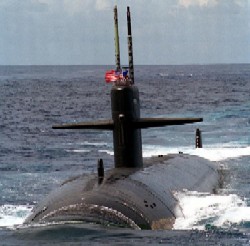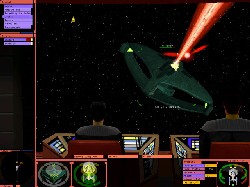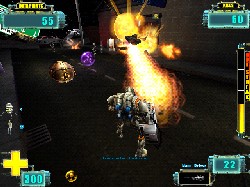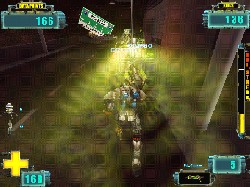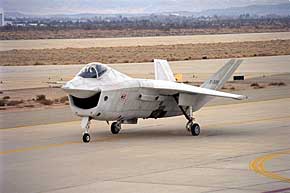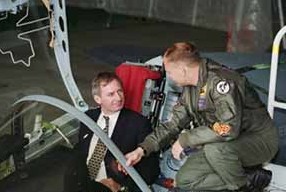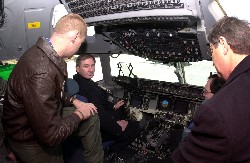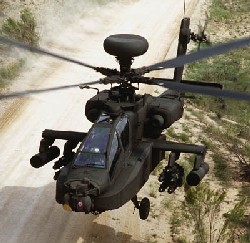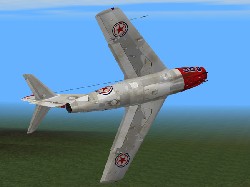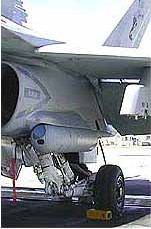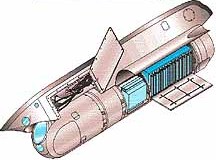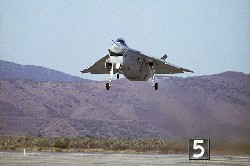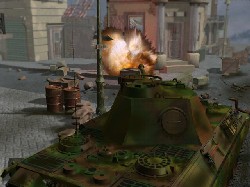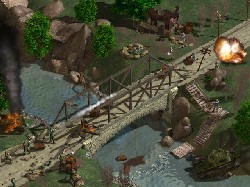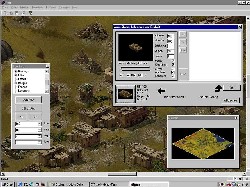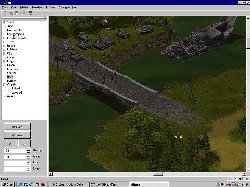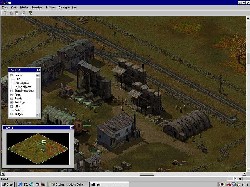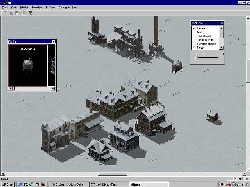Page 1
Daily News
By Gail Helmer
| Send Us News | Archives | Main |
Friday, March 23, 2001
PC News
- Flight Sim Mods Made Easier With gmax.
- AMD Introduces 1.33GHz AMD ATHLON
- MadOnion.com Closes Toronto Office.
- Logitech Introduces Cordless Mouse.
- Electronic Arts Cancels Air Warrior 4.
- NVIDIA Geforce3: Benchmarked- The Director's Cut.
- Raytheon Awarded to Upgrade Submarine Combat Control Systems
- Jane's IDEX 2001 Day 3.
- Jane's News Briefs
- BAE SYSTEMS Awarded US Navy Simulation Contract.
Flight Sim Mods Made Easier With gmax.
Discreet announced at the Game Developers Conference that it is finalizing a definitive licensing agreement to create, publish and distribute gmax Game PACKs for Flight Simulator 2002. Microsoft plans to include similar add-ons in other future simulation titles, including Train Simulator and Combat Flight Simulator.
"Microsoft is quick to embrace trend-setting new technologies—especially in the games space," said Bruce Williams, product planner for flight simulations at Microsoft. "For years, Flight Simulator customers have asked for an easy method to create and modify aircraft, buildings, and other 3D objects and share these modifications with other users. Discreet's gmax is a wish come true for us. Our development team can leverage existing 3ds max exporters and ship these tools with the simulation in the form of a gmax game pack. It's a win for us internally and for customers."
The professional edition of Flight Simulator 2002 will ship this fall with an integrated gmax Game PACK and a free gmax application. This will enable Flight Simulator users to import game content -- including airplanes, buildings, trees and other 3D objects -- and customize them. Users can also build detailed new objects for use with Flight Simulator. For more information on gmax Game Packs visit the: Discreet Website
AMD Introduces 1.33GHz AMD ATHLON
Processor-At CeBIT, AMD announced its continued industry leadership position by introducing the 1.33GHz and 1.3GHz AMD Athlon™ processors. The 1.33GHz AMD Athlon processor-based platforms with Double Data Rate (DDR) memory outperform the Intel Pentium® 4 processor-based platforms by up to 40 percent on a variety of benchmarks, including video encoding, audio, video and image editing, and 3D modeling and animation.
Systems featuring AMD's newest processors are available now from leading U.S. manufacturers such as Compaq Computer Corp., Hewlett-Packard Company and micronpc.com, as well as from top manufacturers abroad, including German-based MAXDATA.
"With its innovative and intelligent core design, systems based on the AMD Athlon processor and DDR memory continue to surpass all competitive PC processor systems in overall performance," said Dirk Meyer, group vice president for AMD's Computation Products Group. "The 1.33GHz AMD Athlon processor, in conjunction with DDR memory technology, provides performance unrivaled by any Intel Pentium 4 processor-based platform available in the market today."
For more on the AMD release of the Athlon 1.3 and 1.33 GHz processors, check out Hardware Centrals Editorial click here
MadOnion.com Closes Toronto Office.
After making 3DMark2001's launch such a phenominal success, leaner times are now ahead for MadOnion.com. COMBATSIM.COM has learned that MadOnion.com will be closing its Toronto office on March 23rd. "MadOnion.com must not only continue on the successful inroads of the past, it must also become leaner if it is to survive in the new realities of the dot-com world, said Paul Bonnette, Internet Marketing. MadOnion.com is a privately held company with venture capital backing, based in Helsinki, Finland.
Logitech Introduces Cordless Mouse.
Logitech marked another milestone in mouse technology with the introduction of Cordless MouseMan® Optical, the long-anticipated mouse that offers both optical precision and cordless freedom. With no ball to clean and no cables to tangle, Cordless MouseMan Optical combines the two hottest features in today's mouse market. The product is scheduled to ship in early April and will be available at retail outlets worldwide and online at www.logitech.com for $69.95 USD.
Electronic Arts Cancels Air Warrior 4.
ELECTRONIC ARTS INC late Monday confirmed that it was planning to lay off an undisclosed number of staff members citing the need to consolidate positions after recent acquisitions. One source close to the company said the job cuts could take place later this week, but an Electronic Arts spokesman declined to comment on the timing. Positions will be eliminated from Electronic Arts' online division, EA.com and game development studios, Electronic Arts spokesman Jeff Brown said. "There's going to be some consolidation, (but) it won't be big in terms of Silicon Valley layoffs," said Brown. He said the company's headcount at the end of the year will likely be the same as the previous or slightly higher. Included in the layoffs was develoment studio Kesmai, to the tune of at least 40 people, which was developing Battletech and Air Warrior 4. Both projects have been cancelled.
NVIDIA Geforce3: Benchmarked- The Director's Cut.
Sharky's Extreme takes the GeForce 3 on a wild ride. Here is a snippet: "The NVIDIA Geforce3: Benchmarked, Overclocked, Analyzed, Supercharged, Raced, Compared, Pixed and Quincunxed plus lots of Scrumptous DX8 screenies! When we first previewed the GeForce3, driver delays and a complete absence of DirectX 8 benchmarks led NVIDIA to keep all performance details under wraps. We've spent the last 48 hours benchmarking our brains out on our sample GeForce3, a Geforce 2 Ultra and an ATI Radeon, so get ready to have your taste of benchmarks (with FSAA) as well as some eye candy, not to mention an analysis of the technology." Click for Full Story: GeForce Hands-on
Military News
Raytheon Awarded to Upgrade Submarine Combat Control Systems
The U.S. Navy has awarded a $20.5 million delivery order to Raytheon Company to replace obsolete military computers and associated software with modern commercial equipment to support enhanced submarine mission capabilities. The order was made under the Advanced Technology Support Program II (ATSP2) contract to streamline the development of upgrades and architecture modifications to the Mark 2 Submarine Combat Control System (CCS MK2).
The Los Angeles-class attack submarine USS Key West (SSN 722)
Raytheon is the CCS MK2 prime contractor and is partnered with a "Team Submarine" coalition of the Navy's Submarine Combat Systems Program Office (PMS-425), the Naval Undersea Warfare Center in Newport, R.I., and several small business partners to meet the requirements of this program.
According to Bill Kneller, CCS MK2 program manager at N&MIS, funding of this project from PEO Subs via the ATSP2 contract leverages acquisition reform initiatives and is a new, streamlined approach for Team Submarine. The ATSP2 contract, which was competitively awarded to RTSC in 1999, provides a framework for governmental agencies to leverage the benefits of the program for advanced technology projects.
Kneller said that the government accelerated the contracting process to meet fleet requirements for submarine upgrades to support a scheduled Tactical Tomahawk test launch during the summer of 2002. By using ATSP2, the Navy was able to issue a Request for Proposal, negotiate the task, and award a contract in about 10 weeks, instead of the normal acquisition period.
This is the first phase of a multi-year initiative by the Navy to achieve Combat Control System commonality among multiple submarine platforms beginning with the upgrading of the Los Angeles class fast attack submarines. Later phases will involve the Seawolf, Trident, and Virginia Class submarines. N&MIS is a premier supplier of integrated naval systems worldwide and has operations in Massachusetts, Rhode Island, California, Hawaii and Washington State in the U.S., as well as in Australia.(U.S. Navy photo by Photographer's Mate 3rd Class James W. Olive)
BAE SYSTEMS Awarded US Navy Simulation Contract.
BAE SYSTEMS has won a $12 million, five-year contract from the US Navy to continue to provide complex computer modelling hardware and software support for Naval Sea Systems Command (NAVSEA). The work entails technical support services - including various types of simulation and performance modelling - for technical groups at the Navy's Coastal Systems Station (CSS) in Panama City, Florida. This contract is the unit's fourth consecutive award for similar work for the Navy in the last 13 years.
BAE SYSTEMS supports the Coastal Systems Station's Simulation Engineering Branch and Coastal Warfare Evaluation Systems office. Projects that BAE SYSTEMS supports include the Naval Mine Warfare Simulation; the Naval Visualisation Programme; the Autonomous Littoral Warfare Systems Evaluator; the Technology Requirements Model; and the Naval Simulation System among others.
"Our partnership with Coastal Systems Station experts has provided the Navy with cutting edge modelling and simulation expertise in the areas of sonar and optic sensors, combat systems, acoustic countermeasures, and signal processing. This support has been vital to developments in littoral warfare mission areas," Dr. Lawrence Howell, Programme Manager for CSS said.
The Coastal Systems Station, one of the Navy's major research, development, test, and evaluation laboratories, has expertise in science and technology, engineering, modelling and simulation, and test and evaluation. Its mission areas include littoral, mine, amphibious and special warfare, diving and life support, and coastal operations.
Thursday, March 22, 2001
Lock On: Modern Air Combat Update.
- Lock On: Modern Air Combat Update.
- Star Trek: Bridge Commander Screen.
- X-COM: Enforcer Website Launched.
- Saitek to Create Tactile Feedback Mouse.
- New TRIBES 2 Game Incorporates TouchSense Technology.
- EBWorld to Deliver Games On Demand.
- Boeing Leaving Seattle After 85 Years.
- Boeing Completes Final JSF X-32B Flight-Certification Tests.
- Engine Failure Cause Of F-16 Crash.
- UK Defence Minister Gets Little Indication Of JSF Future.
Although it was sad news to hear that Ubi Soft had cancelled Harpoon 4 earlier this week, it is good to see other SSI titles are still moving on. Matt Wagner has lifted our spirits by bringing us up to speed on Lock On: Modern Air Combat's progress.
Some of things in place include:
Also, the Flanker Team have requested input on Lock On AI. If you would like to voice opinion on what you did or didn't like about the Flanker series AI and what you might like to see in Lock On's, head over to the Flanker 2.com Forum
- Ground vehicles move and engage. Vehicles can be made to follow roads, independently drive around obstructions, and be placed within formations of various types of vehicles. When on the move, they kick up varying amounts of dust depending on the surface. Watching armor battles is pretty darn cool.
- Ability to jump from cockpit to cockpit.
- The A-10 is just about done. The A-10 has all unique avionics systems (HUD, RWR, weapons panel, TVM, steam gauges, etc.), flight model, and sounds. Most of this is based on unclassified Dash One manuals. I can say with confidence that it will be the must authentic A-10 simulation ever done for the PC.
- F-15C is flyable and we have a really nice preliminary cockpit. The F-15C is going to be a real looker.
- We have some new flight model cheat OPTIONS for new players. These include auto-spin recovery and speed retention according to G.
- Missile padlock. See, we read your wish list items.
- Non-flyable F-4E, F-5E, and Tornado IDS. There’s an additional one the team is working on but I’m going to be evil and let you guys guess on that one.
Star Trek: Bridge Commander Screen.
Activision has released a new screenshot from Totally Games' upcoming space combat simulation, Star Trek Bridge Commander.
X-COM: Enforcer Website Launched.
Microprose has launched the official website for X-COM: Enforcer, its Unreal powered arcade shooter. The site features screenshots, gameplay tips, a downloads section, and more XCOM Enforcer Website
Saitek to Create Tactile Feedback Mouse.
Immersion Corp., today announced that Saitek, a gaming peripheral designer and manufacturer, is incorporating Immersion's patented TouchSense(TM) technology into a new optical computer mouse with tactile feedback capabilities. This mouse will allow everyday PC users to feel objects and actions that correspond to events, graphics or icons on a computer screen. Now gamers can reach new levels of interaction in some of the the hottest game titles such as Black & White, TRIBES 2 and Unreal Tournament using Saitek's new mouse configured for a wide range of game play.
Immersion's developer tools and several hardware products with Immersion's TouchSense technology will be on display at Immersion's booth No. 528 at the Game Developers Conference in San Jose, California, March 22-24.
New TRIBES 2 Game Incorporates TouchSense Technology.
Immersion Corp.,today announced that Dynamix, a division of Sierra, has incorporated TouchSense(TM) technology into its newest release, TRIBES 2, one of the gaming industry's most anticipated team-based action games. Using Immersion's patented TouchSense technology, Sierra added high-quality tactile sensations that correspond to onscreen action events within TRIBES 2. These sensations add the missing sense of touch to visual and audio effects, bringing a whole new dimension of realism to the gaming experience. TRIBES 2 offers PC gamers new tactile weapon effects as they explore and battle in massive and breathtaking worlds. Sample tactile sensations can be experienced at the weapons section of the TRIBES 2 web site
EBWorld to Deliver Games On Demand.
EBWorld.com and Into Networks have announced a long term agreement to deliver games on demand. Into Networks is licensing its streaming software technology to Electronics Boutique and Enron is providing strategic, financial and operational services to Into to offer broadband customers secure access to software on a rental basis.
Beginning June 1, Electronics Boutique will offer customers leading game titles via its website powered by Into's streaming software on demand technology. This technology allows users to access software without requiring downloading or installation. To ensure security, the content will be encrypted and encoded using Into's proprietary technology. Electronics Boutique will be responsible for marketing and customer service.
Into's streaming technology platform provides publishers and retailers another distribution channel for generating revenue and gives customers a new option for renting games. Electronics Boutique will acquire the streaming rights from leading publishers to aggregate popular and newly-released game titles.
Military News
Boeing Leaving Seattle After 85 Years.
Boeing has stunned the United States by announcing that intends to move its corporate headquarters from Seattle, its home since the founder Alfred Boeing opened his first workshop there in 1915.
Announcing this yesterday in New York Phil Condit, Boeing chairman and chief executive officer said, "We intend to take a more global view of opportunities to increase shareholder value...As we've grown, we have determined that our headquarters needs to be in a location central to all our operating units, customers and the financial community -- but separate from our existing operations."
Boeing has three metropolitan areas under consideration for its world headquarters: Chicago, Dallas/Ft. Worth and Denver. The company hopes to have site selection made by early summer and have an operational centre in its new headquarters by the autumn.
Boeing Completes Final JSF X-32B Flight-Certification Tests.
Boeing this week successfully cleared the last ground-test hurdle for flight certification of its Joint Strike Fighter X-32B concept demonstrator. Final engine runs, in the short-takeoff-and-vertical-landing (STOVL) mode, were completed with Pratt & Whitney and Rolls-Royce flight-certified propulsion system hardware and the final validated integrated flight and propulsion control software.
"This is the culmination of a series of tests in which we demonstrated the ease and operational flexibility of direct lift," said Frank Statkus, Boeing vice president and JSF general manager. "Boeing is ready to go fly STOVL.
"Hovering is the easy part — it's the transition between conventional and vertical thrust that is key to STOVL. The tests confirmed our system's ability to do just that and demonstrated the low-risk aspect of our third-generation direct-lift solution."
During the final engine runs, the test team, which includes Pratt & Whitney and Rolls-Royce, conducted flow-switches, redirecting engine thrust from the aircraft's cruise nozzle to the lift nozzles and back again.
The X-32B will demonstrate the company's direct-lift solution to the STOVL requirements for the U.S. Marine Corps and the United Kingdom's Royal Navy and Royal Air Force.
To perform STOVL flight, the system closes the rear exhaust nozzle and redirects engine thrust downward through lift nozzles. For conventional flight the lift nozzles are closed, and thrust flows rearward through the two-dimensional thrust-vectoring cruise nozzle — the same as in the X-32A — to propel the aircraft forward and to supersonic speeds. The afterburner is not used during STOVL operations.
The next major milestone for the X-32B will be high-speed taxi tests later this month, followed shortly thereafter by first flight. (Boeing Photo)
Engine Failure Cause Of F-16 Crash.
Engine failure caused an Oklahoma Air National Guard F-16 Fighting Falcon to crash Oct. 12 near Atlanta, Kan. The aircraft was assigned to the 138th Fighter Wing at Tulsa International Airport. The pilot experienced only minor injuries after ejecting from the aircraft. Air Force officials investigating the accident found evidence that the No. 3 bearing assembly completely broke-down, causing the engine to seize. During the air-to-air training mission, the pilot heard a ratcheting sound from the engine and felt a violent vibration of the airframe. This was followed by a bang, rapid engine deceleration and subsequent engine shut down. The pilot tried twice to restart the engine but was unsuccessful. The pilot ejected from the aircraft after his wingman radioed that the aircraft was on fire. The F-16 crashed into grazing land, causing minor property damage.
UK Defence Minister Gets Little Indication Of JSF Future.
UK Defence Minister Geoff Hoon got little reassurance that the Joint Strike Fighter programme was still on track when he held discussions with his US counterpart, Secretary of Defence Donald Rumsfeld in Washington yesterday. The UK recently committed $2 billion to JSF development, yet it remains one of the three fighter programmes that are part of the US administration's 'root and branch review.
Mr. Hoon seated in X35.
Secretary Rumsfeld, speaking to reporters at the Pentagon would not say that it was safe to assume the JSF programme would go ahead. " It would be wrong. It would be imprudent, unwise," he said, to comment on a study that had not yet been delivered to him. "We have lots of pieces of the puzzle that are moving down the train track, and we're looking at them all, and when we're ready to (decide), we shall do so."
At the conference Mr Hoon had said that the JSF project would "...strengthen the United Kingdom and European capabilities whilst promoting co-operation and interoperability across the Atlantic and within the alliance." He confirmed that the Joint Strike Fighter was the preferred option for the carriers that the UK was committed to building.
Mr. Hoon(seated) briefed on the capabilities of the C-17 Globemaster III.
The Defence Minister also visited Andrews AFB to briefed on the C-17 Globemaster strategic transport. The RAF is due to receive four of the aircraft on a lease arrangement with Boeing, beginning in May this year. Pilots and loadmasters from the RAF's 99 Squadron are undergoing operational training on the aircraft at Charleston AFB in South Carolina in readiness for its introduction into service. (Photo by Staff Sgt. Angela Stafford)
Wednesday, March 21, 2001
PC News
- Operation Flashpoint: Cold War Crisis Demo Released.
- Hercules Announces Gamesurround Muse* XL.
- NVIDIA's GeForce3 In Action.
- Beta Testers Wanted For New War Game.
- Horse & Musket Patch v1.13 New Terrain Added.
- Lockheed Martin's Awarded CVN(X) Contract.
- IDEX 2001 Day 2.
- Egyptian Apaches Upgrading To AH-64D Configuration.
Operation Flashpoint: Cold War Crisis Demo Released.
Codemasters has announced the release of the demo for the tactical military combat simulation under development with Bohemia Interactive Studio, Operation Flashpoint: Cold War Crisis.
In this demo there is one level available, in which you play as a part of an infantry squad. Your squad's mission is to neutralise the hostile forces in a small area of one of the islands in the game. In the full game you can look forward to a full campaign, featuring over 30 missions. You will be able to play as an infantry soldier, a tank commander, a pilot and a special forces operative. Eventually, you will also be able to command other troops in combat to test your tactical skills as well as your combat awareness. Click Here To Download Demo
Hercules Announces Gamesurround Muse* XL.
Hercules has announced its new Gamesurround Muse* XL, the follow-up to the Maxi Sound MUSE*. With an extended list of features, Gamesurround Muse* XL is the sound card for gamers who want the best without blowing their entire budget on one sound card. Gamesurround Muse* XL, based on a CMI-8738 audio chipset comes with full Sensaura* 3D Positional audio technology on its 4-speaker outputs. The sound card includes: Game Commander 2 SE, and MUSICMATCH for maximum MP3 enjoyment. Gamesurround Muse* XL will be available to at the end of March 2001 for $29.99 (USD). For more information go to the: Hercules website
NVIDIA's GeForce3 In Action.
Wondering just how good the GeForce3 is? NVIDIA has announced feature highlights of an upcoming game that leverages NVIDIA technology. Take a look at how Massive Development uses the nfiniteFX engine to create stunning scenes and characters. NVIDIA's GeForce3 and AquaNox Using the GeForce3's nfiniteFX engine to deliver photo-realism in real time, AquaNox uses more than 160 Vertex Shaders to implement special effects such as layered fog, caustics, photo-realistic materials, radiosity lighting, and real-time shadows. Higher order surfaces are used to create organic enemies, and Pixel Shaders are utilized for bump mapping and volumetric lighting effects. Download the demo here: GeForce3 & AquaNox
Beta Testers Wanted For New War Game.
Shrapnel Games has announced that they have a new project available for testing. The game is a Real Time 3D wargame set in the near future. All testers must meet certain requirements and only sign up if you have a significant amount of time to invest in testing. Anyone interested in testing should send a note to [email protected] with the following info:
Horse & Musket Patch v1.13 New Terrain Added.
- Your Testing Experience
- Your 5 favorite games
- The 5 last games you played
- And anything else you think is applicable.
Shrapnel Games announced today that a new patch has been released for Horse & Musket: Great Battles of the Eighteenth Century. The Patch, version 1.13, adds features requested by the Horse & Musket Gamers. Click Here To Download Patch
Included in the Patch:
Military News
- In the Edit Army Names dialog (under the Armies->Edit Names menu) there are now edit boxes to the right of the army names that you can use to enter the bitmap name for that army.
- Infantry can no longer initiate assaults with cavalry
- It now costs a cavalry unit 2 Movement Points to disengage (instead of all).
- When a Corp Leader is promoted to Overall Leader, he keeps his name.
- New terrain graphics are add
ed.
Lockheed Martin's Awarded CVN(X) Contract.
Lockheed Martin announced today that it has been awarded a $446 million contract by Newport News Shipbuilding to develop the Integrated Warfare System (IWS) that will pave the way to the next generation of aircraft carriers. The contract has an additional $40 million option for added scope. This award marks Lockheed Martin's strong entry into the nuclear aircraft carrier market. The lead company for this contract is Naval Electronics and Surveillance Systems-Surface Systems (NE&SS-SS), which will apply its expertise in integrating diverse systems into a single, open-architecture, scaleable weapon system based on off-the-shelf computer technologies.
Newport News Shipbuilding will be able to deliver the latest in technology to its Navy customer because Lockheed Martin will integrate all onboard warfare decision centers, eliminate stove pipe systems, and provide a design that supports cost-effective upgrades over the 50 year life of the ship. The as-yet unnamed CVN 77 will be the transition ship from the current Nimitz Class aircraft carriers to the next class of carriers, termed CVN(X).
Fred P. Moosally, president, Lockheed Martin NE&SS-Surface Systems, added, "The integration and delivery of the CVN 77 warfare system is the first time individual systems such as sensors, command and control and self defense functionality will be available over a commercial information infrastructure in a U.S. aircraft carrier. Through our Open Business Model(TM)* process we can apply the most advanced technologies available at the lowest cost throughout the design, development and production phases."
Lockheed Martin's systems engineering, development and integration work will be performed primarily in the new Virginia Advanced Ship and Carrier Integration Center (VASCIC), that will open this summer adjacent to Newport News Shipbuilding.
Best known for designing, building, and integrating the Aegis Weapon System into U.S. destroyers and cruisers, Lockheed Martin NE&SS-Surface Systems has designed a number of fully integrated, complex systems for other classes of surface ships. Core competencies include radar and RF sensors, command and control systems including C4ISR systems, shipwide integrated computing infrastructures and integrated topside designs. It is one of five major lines of business comprising the Lockheed Martin NE&SS business segment, which serves surface ship and submarine customers worldwide. NE&SS is an operating segment of the Lockheed Martin Systems Integration business area.
Egyptian Apaches Getting Upgrade To AH-64D Configuration.
The U.S. Army has authorized The Boeing Company to begin procuring long-lead items for 35 Egyptian Army AH-64A Apaches that will be upgraded to the next-generation AH-64D Apache configuration. The foreign military sales contract with Egypt is expected to be finalized in the coming weeks. Deliveries are scheduled to begin in 2003.
Egypt initially announced its intention to upgrade its helicopters late last year. The total value of the program - including aircraft, ordnance, spares, training and support - is anticipated to be approximately $400 million.
Domestically, Boeing is nearing completion of the first multi-year contract to deliver 232 remanufactured AH-64D Apache Longbows to the U.S. Army through 2001. In September 2000, Boeing and the U.S. Army signed a second five-year, multi-year contract to remanufacture an additional 269 AH-64As into the Apache Longbow configuration through 2006. Defense forces from several international customers also are considering upgrading to the Apache Longbow.
Tuesday, March 20, 2001
PC News
- Harpoon 4 Cancelled!
- New Operation Flashpoint Fan Site Launched.
- Target Korea Update.
- Boeing ATFLIR For F/A-18's.
- Jane's News From IDEX 2001.
- Aviation Week Reports On JSF Stealth Engine.
Harpoon 4 Cancelled!
With the recent acquisition of Game Studios by Ubi Soft earlier this month, the future of SSI and its simulations titles were in question. COMBATSIM.COM has learned that Ubi Soft has reviewed all the titles in the works: Lock On: Air Combat, Silent Hunter II, Destroyer Command and Harpoon 4. "Ubi Soft likes the SSI Brand and is enthusiastic about these upcoming titles, said a Game Studio press agent. However, after 4 years in development, Harpoon 4 "did not make the cut". Carl Norman told COMBATSIM.COM, "We don't want the community to see this as a bad thing, we simply had to focus our resources on the products we are keeping." Although Ubi Soft has approved Lock On: Air Combat, Silent Hunter II, Destroyer Command it is expected the release dates will slip.
New Operation Flashpoint Fan Site Launched.
OperationFlashpoint.com has officially opened. There is a Q&Q with Marek Spanel (producer of Operation Flashpoint)at Q&A.
We also got word from Codemasters that the Operation Flashpoint Demo will be released at: 21 March 9:30 GMT
Target Korea Update.
For the first time anywhere, Targetware showed various work-in-progress screenshots of some of the terrain to be used in its upcoming release of Target Korea. In response to reader's questions, some highly unique features of the dynamic Targetware terrain engine were revealed in the interview. The engine itself is based upon what is called a split-only ROAM queue, which is the same algorithm NASA uses for its simulators. A link to this and other Targetware interviews may be found at: Targetware.net
Military News
Boeing To Produce ATFLIR For F/A-18's.
The U.S. Navy has awarded a $69 million contract to The Boeing Company for low-rate initial production of 15 Advanced Targeting Forward Looking Infrared (ATFLIR) systems and spares. The contract covers production of 14 ATFLIRS for the F/A-18E/F Super Hornet and one for the F/A-18C/D Hornet. Developmental testing on this third-generation FLIR has been under way at Boeing facilities since 1998.
"The ATFLIR will be more reliable than today's system and significantly more capable," said Tony Parasida, Boeing vice president for the F/A-18 program. "Pilots are looking forward to the ATFLIR's enhanced detection ranges and greater designation and standoff ranges."
The ATFLIR will replace the existing electro-optic sensor suite, combining separate navigation FLIR and targeting FLIR pods into one pod, freeing up one weapon station. The ATFLIR also includes a visible light camera (electro-optic sensor). The third-generation FLIR will provide the capability to detect, classify and track both air-to-air and air-to-surface targets; it supports the autonomous delivery of existing laser-guided weapons and emerging standoff weapons.
Boeing has delivered 44 Super Hornets to the U.S. Navy, all on time or ahead of schedule. Boeing has orders for 284 Super Hornets. The Navy plans to buy a minimum of 548 of the aircraft. An industry team led by Boeing builds the Super Hornet. Boeing builds the forward fuselage and wings, and completes final assembly. Northrop Grumman Corp. is the principal airframe subcontractor, supplying the center and aft fuselage. General Electric Co. produces the engines, and Raytheon Co. manufacturers the aircraft's radar.
Aviation Week Reports On JSF Stealth Engine.
A report in the March 19 issue of Aviation Week & Space Technology reveals the secrets of new technologies created to eliminate radar reflections from air inlets and engines of the Joint Strike Fighter. "In a clever use of technology (a technique considered a proprietary secret by the two companies), Boeing and Pratt & Whitney worked together to add stealth to the inlet guide vanes to mask the fan blades behind them. The inlet vanes are variable and open to provide maximum air to the engine in vertical flight, but close to minimize radar reflections during flight at operational altitudes,'' reports AW&ST.
The Boeing JSF's intake radar blocker is built as part of the face of the engine with a bullet-like centrepiece surrounded by angled, radiating vanes. In parallel, the US has developed infrared and radar suppression devices for jet exhausts that have been flying on US stealth aircraft for a number of years. These two types of blockers are generally used in conjunction with one another, and the latter has become increasingly sophisticated as researchers find better ways to deal with an environment of extreme exhaust heat.
Knowledge of the emerging JSF technology also provides insight into the broader evolution of cheaper, reliable, low-maintenance stealth and critical low-observability improvements in other programmes such as the Air Force's F-22 Raptor and Navy's F/A-18E/F Super Hornet.
The Joint Strike Fighter competition has yielded secrets about the stark differences in the methods contractors have used to manipulate stealth technologies, in particular to eliminate radar reflections from air inlets and engines.
According to the article, "The JSF competition is a good primer for how technology and tactics can be employed to keep radar from reflecting out of engine, exhaust and weapons bay cavities. The front of Boeing's JSF engine, for example, is only a few feet inside the air intake. To avoid radar reflections, the engine face has been hidden by special inlet guide vanes that have been treated with radar-absorbing materials (RAM) and shaped to cause radar beams to make multiple bounces, including onto the air-duct walls. There, radio-frequency energy is trapped by RAM or bounced from interior surfaces, each time being greatly attenuated. One way or another, the radar energy becomes too weak to constitute a dangerous reflection.
"By contrast, Lockheed Martin and McDonnell Douglas had both developed serpentine air ducts leading to the engine to avoid such reflections. The ducts coil horizontally and vertically on the way to the engine to avoid a line-of-sight path for radar. Once into the ducts, most radar beams are directed onto surfaces made of, or coated with, RAM. Radar specialists say that after a couple of bounces, there's virtually no radar energy left for a dangerous reflection.''
Advocates of the Boeing design say new technology makes the short inlet a better bet. "The issue is purely one of how much distance is involved in dealing with the (radar) energy," said an aerospace industry official with long experience in the JSF competition. "While the longer inlets are generally easier to model (and build), they consume a lot of internal volume in the aircraft and often produce aerodynamic or maintenance challenges."
"Boeing's JSF demonstrator is designed for direct thrust from the engine to provide its STOVL capability," the article says. The engineering demands of the system required the engine to be much farther forward in the fuselage, allowing only enough room to hide the upper half of the engine face. Instead, Boeing is using a radar blocker built ahead of the engine's face, similar to that developed for the company's F/A-18E/F. The Super Hornet design differs in that it combines slightly curved inlets with a blocking device on the engine face.
"With the distinct differences between the two JSF designs, Boeing and Lockheed Martin are offering the Pentagon a lot of clear-cut choices in STOVL systems, inlet designs, weapon bay positioning and sensor arrays, aerospace industry officials agree," according to AW&ST.
Boeing and Lockheed Martin are competing to build the JSF for the US Air Force, Navy and Marine Corps and the Royal Navy and Royal Air Force. A down-select decision is expected later this year, if the programme survives the Bush Administration's ongoing 'root and branch' review of defence programmes.(Boeing Photo)
Monday, March 19, 2001
PC News
- CDV Software Entertainment Announces Warcommander.
- New Sudden Strike Forever Screens.
- Power Of Information Drives C3i Market.
- Rolls-Royce Delivers Key Components For Astute Submarines.
CDV Software Entertainment Announces Warcommander.
Warcommander is a real time tactics play in the style of the Megasellers Commandos. In ISO perspective the player directs a visible number of units with specific strengths and weaknesses. Scene of the happening is the Second World War in Europe. The combat team of up to 50 allied soldiers from 11 different unit types is arranged before the application. Two campaigns from the view of the American armed forces, also over 30 stretching Leveln and additional special missions connect strategic puzzles and adrenalin-driving Action. Release Date: Autumn 2001.
New Sudden Strike Forever Screens.
This week CDV presents four new screenshots of the offspring of Sudden Strike, Sudden Strike Forever. Showing today: the new map- and mission editor. Enjoy the screens!
A nice present for the British: a tank.
The bridge of Arnheim?
US units in the industrial area.
We build this city...
Military News
Power Of Information Drives C3i Market.
"Information is power. Who has it and who does not is now an important, influencing factor in contemporary warfare," said Richard Sterk, Electronics Group Leader and Senior Analyst for Forecast International/DMS, adding "how one delivers information is of even more importance, especially in the international Command, Control, Communications, and Intelligence (C3I) market."
In its annual "C3I Market Overview" analysis, Forecast International predicts the world C3I market will generate more than $82.7 billion in sales over the next ten years.
"The present trend in the C3I market appears to be large scale production of systems researched and developed in the past. It is anticipated that this production will slowly drop off after several years," said Sterk. "However, by the end of Forecast International's ten-year forecast period it is expected that the funds lost on systems no longer in production will be redirected into research and development (R&D) programmes aimed at developing the replacement systems for those currently in production."
Forecast International's C3I market overview forecast period covers the years 2001 through 2010.
According to the statistics in this analysis, the C3I market's value ranges between $8.1 billion predicted for 2001 to $6.6 billion predicted sales in 2010. From 2001 through 2003, there is an increase in predicted sales peaking at 8.8 billion. Values are expected to decrease in 2004 due to the end of production for some programmes. However, a huge increase in procurement and R&D beginning in 2005 will increase sales from $9.37 billion to $9.4 billion in 2006. Amounts will again slide in 2007 as the market waits for the next round of future technology to be developed.
Advanced C3I systems and technology allow for a radically more effective military. However, to achieve such effectiveness, militaries must address several needs and vulnerabilities within existing information technology systems, as well as address interoperability challenges, said Sterk, adding that with the move from global to regional conflicts, in which many nations are operating as one "team," joint interoperability determines who has this much-needed information.
Joint operations will continue to be the norm with militaries responding to contingencies on quick notice that force them to deploy with minimal time for preparation. Many of the systems presently in use are older systems originally built as a standalone application for a single purpose that rely heavily on military specific technology. To get all the services, and in many cases, nations, working together, watch for a growing use of COTS technology to link and integrate the C3I systems of these hastily made coalition forces. Achieving adequate C3I interoperability has become one of the top priorities of the 21st century. "This interoperability is a definite requirement on the part of many governments, companies focusing on this technology will find themselves in good bargaining position," said Sterk.
"The real world has finally caught up with science fiction as more nations try to digitise themselves right down to the individual ground soldier," said Sterk in highlighting the new developments of several soldier systems. "This emphasis on the individual solider is expected to provide them with information in advance of difficulties," Sterk said, adding "such systems as helmet mounted displays, advanced and modified weapons and weapon sights, radios, navigational systems etc., are all expected to provide the individual soldier with information he needs to effectively carry out his mission."
Many nations are focusing on developing individual soldier systems, such as: the Dutch Dismounted Soldier Systems (D2S2) for the Nether-lands; the FELIN for France; the FIST, CRUSADER 21 for the UK; the Force XXI Land Warrior for the US; the Future Infantryman for Germany; the Integrated Protective and Clothing Ensemble for Canada; and the Soldier Combat System for Australia.
Satellite-based and connected systems also are playing a more extensive role in the battle of "who has the most information." Advanced satellite communications give military forces the ability to quickly receive vital information at the same time as the higher commanders, and find out where their allies are located at the push of a button. Advanced satellite communications will also speed up the transfer of information to between a few seconds and a few minutes, whereas the transfer previously took minutes to hours.
According to the Forecast International analysis, to be successful, C3I products in the next ten years must satisfy a number of requirements, not the least of which will be high performance at a good cost. Many militaries now are requiring systems that can be tailored to their own particular needs and environment making COTS technology important for quick development but by no means a "get rich quick" scheme for companies.
Systems and products will need to be modular, with easy adaptability to different wants and changing requirements, and upgrades a matter of months, not years. While these products will be technologically advanced, they will not be so sophisticated that training military personnel in their use is too expensive and time consuming, or requires too high a level of education in which in this case simulation technology will be increasingly important as a way of keeping costs down in training.
"The push among world militaries is to modernise and digitise, making the C3I portion of the overall world defence industry a hot market, relatively speaking," said Sterk. "Many systems are in the throes of massive upgrades. The generation of systems that have been in development all these years are finally making their way to the battlefield. Over the next ten years, a fury of electronic equipment procurement, upgrades, and modernisation is forecast."
Forecast International/DMS provides Market Intelligence and Analyses in the areas of aerospace, defense, power systems and military electronics.
Rolls-Royce Delivers Key Components For Astute Submarines.
Rolls-Royce has delivered the largest single propulsion plant component for the first boat in the Royal Navy's new Astute class of nuclear powered attack submarines to prime contractor BAE SYSTEMS. The RPV houses the reactor core, also made by Rolls-Royce in Derby, and is the heart of the nuclear steam raising plant Rolls-Royce is supplying for Astute and her two sisters, Ambush and Artful, under a fixed price contract with BAE SYSTEMS.
Early delivery will enable the shipyard to make progress on key pipework systems. In common with earlier designs, the propulsion plant has a design life of more than 25 years. However, Astute will be fitted with the new long-life core, which powers the submarine for its full service life and eliminates costly reactor refuelling.
David Price, Managing Director - Naval Marine for Rolls-Royce, said, "The design and manufacture of the nuclear plant is making excellent progress with many other sub-systems in manufacture."
Under a £2 billion Prime Contract, BAE SYSTEMS is undertaking the design, build and initial in-service support of three 7,200 tonne Astute Class Submarines Type SSN for the Royal Navy. The Prime Contract has the potential for further submarines of the Class and includes weapons upgrade of boats in the previous S&T Classes being undertaken by BAE SYSTEMS at Weymouth.
| Send Us News | Archives | Main |

